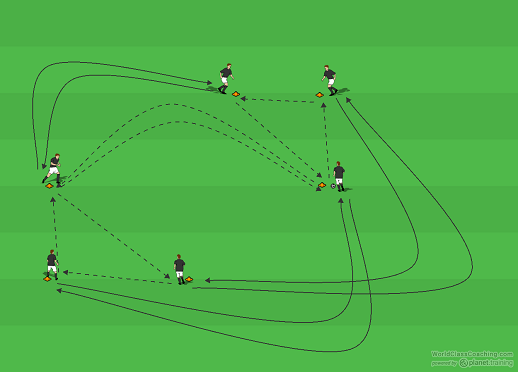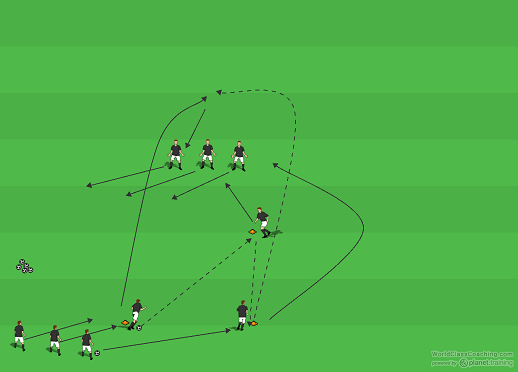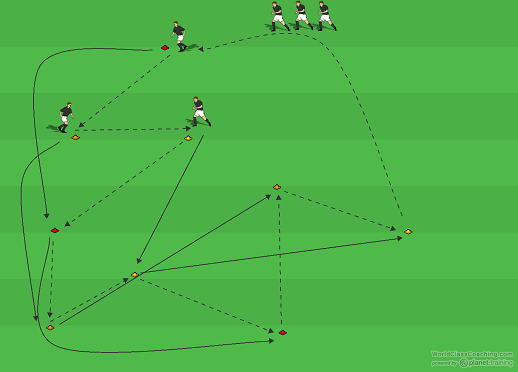By Mike Smith
So many good things come from basic triangle passing. 2 players can use wall passing in triangle shapes to consistently move the ball. 3 players moving in triangles adds even more to the equation. And, many times during a game, a team will find itself with its back 4 holding a line, 2 forwards staying up and 1 mid playing wide leaving only 3 players to handle the bulk of the movement with in the formation. This session focuses on triangle movement, passing and spacing using multiple game scenario passing patterns.
Lesson 1
1, 2, 3
Set-Up
Space 2 10yd triangles 20 yds apart. Two groups of 3 players will rotate between the triangles. ( multiple stations can be set up to accommodate all players ) The groups will alternate between having to run each triangle in succession or holding. The starting player in each triangle will make two passes before rotating, the other players move immediately after making their pass. The starting player sends the ball to another point on the triangle. This player sends the ball to the remaining player, who then sends it back to the starting player. The starting player then sends a longer pass to the group waiting in the next triangle. Once the drill starts, it becomes more fluid. The receiving group repeats the passing pattern but this time has to rotate to an empty triangle, keeping the ball moving, before passing it back. Both groups then repeat the process for a set amount of time.

Coaching Points
The coach should make sure the groups understand the rotation and work to keep the ball moving between the triangles and the groups. Good touches, passes and communication are a must.
Drill 2 Set Up
Three groups of three players simulate using triangle shapes and passing to get behind their opponent. One groups starts on a 15 yd triangle. The starting player passes up to the top of the triangle ( as shown ) and then runs behind a wall of players made from another group of 3. The player at the top of the triangle drops the ball back to the remaining player who lofts the ball over the wall of players where the starting player makes the reception. The group that started on the triangle then becomes the wall, a holding group steps in to the triangle and the group that was the wall holds to enter on the next rotation.

Coaching Points
This is a great activity to work on timing and bringing a lofted or lobbed ball under control. The coach should focus on the accuracy of the lob and the touch used to bring the ball under control.
Lesson 3
Red, Orange, Yellow
Set Up
Set up 3 15yd triangles 15 yards apart in a counter clock wise circle. Each triangle will have a red, orange and yellow cone. ( If you do not have multi colored cones use 1, 2 and 3 cones respectively at each station and make the pattern, 1,2,3. ) 3 players move around the cones following the Red, Orange, Yellow progression. The player who starts on the red cone, passes to the orange cone and then moves to the next red cone. The player on the orange cone receives the pass and passes to the yellow cone. After receiving the ball , the player on the yellow cone passes to the red cone ( and waiting player ) in the next triangle. The group works its way through, making various runs ( as shown ) until the yellow player send the ball back to the next group at the start ( after their 3rd reception).

Coaching Points
Passing and moving is the key here. The combination of short and long passes with bent and diagonal runs is very game applicable. The coach should encourage the players to get through this very cleanly and at game speed.
Lesson 3
Half Field Scrimmage with Touch Limits
Set Up
No diagram needed here. Move a goal to the midfield stripe and let your team scrimmage in a half field. The only catch is a decreasing touch limit. Start with a 3 touch per player limit. After 15 minutes, reduce the touches to 2. If so inclined, after an additional 15 minutes, play a one touch game. IF a player reaches the touch limit they must simply back away from the ball. Any time a player exceeds the touch limit, a direct free kick is awarded to the opposing team.
Coaching Points
The touch limit forces passing and utilizing the patterns and movements from the session’s drills. The coach should help manage the touches as well as encourage the players to make supporting runs, communicate and utilize accurate passing to create possession, relieve pressure and create high quality chances to score.
By Mike Smith
Currently the Head Coach for University Heights Academy Boys Soccer in Hopkinsville, KY , Mike is in his 14th year as a high school head coach with 23 years coaching experience overall and 34 year as a student and fan of the game. He holds a USSF D License.


